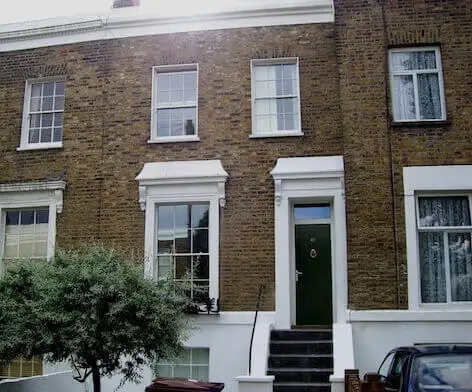
Installed Measures:
Personal Story:
I am in the business as an energy consultant and my partner, Bronwen, is in the NGO sector.
I have co-authored two papers about the design and operational performance of the house which were presented at the International Passive House conferences in 2010 and 2012 respectively.
Motivations:
My motivation stemmed from a professional interest and from environmental drivers. I also wanted to see exactly what was possible to do to such a property in terms of increasing its comfort and reducing energy consumption. I’m obsessed about how much energy we actually are using, so I do keep track of that and obviously this is affected a lot by behaviour.
When we bought the property it had central heating but apart from that it hadn’t been upgraded for a family to live in. It needed rewiring and re-plumbing as well as a new bathroom, kitchen and roof.
We set out to cut energy use by 80%. Our aim was to demonstrate that future generations can live in such homes without guzzling fossil fuels and that a hard to treat house can be transformed into a low energy dwelling as well as a delightful home.
Property:
This mid terrace, 4 storey, 3 bedroom property was built in 1830. We bought the property in May 2007 and upgraded it in 2009, moving in to the house in January 2010. Due to the properties age and location it is subject to certain conservation laws and building restrictions, particularly on the front façade.
Measures:
The main changes made during the refurbishment included installing a lot of insulation and double and triple glazing helping to make the property airtight. We also installed underfloor heating in the basement and PV panels on the roof.
Benefits:
The house is very airtight so when the windows are closed there are certainly no draughts. I would say that about 90% of the time the temperature in the house is absolutely right. Except in very cold conditions, internal temperatures remain stable at around 20°C. Even areas with no direct heating only fall below 18°C when external conditions fall below 0°C. The lowest recorded temperature in the upper ground area was 17.4°C during a week long sub-zero spell, due to the large spatial area and glazing. But even then it remains toasty warm in the kitchen and bathrooms.
The air quality is much better, the house is much more sound proof and there is a lot more natural daylight throughout. Our home security has also been improved by the refurbishments, which we realised when we managed to lock ourselves out one day.
Another benefit is the reduction in our energy bills. In fact, we now have negative energy bills as we use so little energy and benefit from a feed-in tariff for our small PV system. Gas use in 2011 was 4,660 kWh (39 kWh/m2) of which 3,500 kWh (29 kWh/m2) was for space heating and the rest for hot water and cooking. Electricity use in 2011 was 1,550 kWh (13 kWh/m2) of which 1,225 kWh (79%) was generated by our PV system. Total emissions for 2011 were 1.1 tonnes of CO2, an 84% reduction.
Favourite Feature:
A combination of all the measures working together means that the house is very comfortable to live in. It’s only by doing everything that we’ve done, as a holistic approach, that we are now in a position where conditions in the house are so good. But if I have to say one thing that stands out, it is the daylight and sunshine that pours into all the rooms.